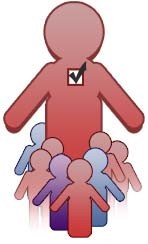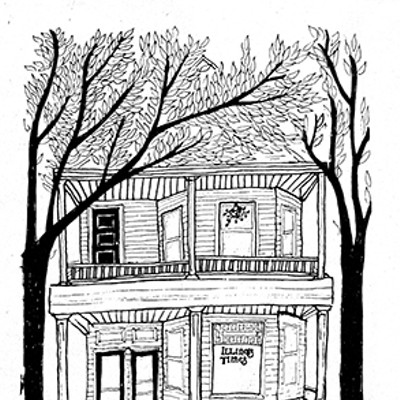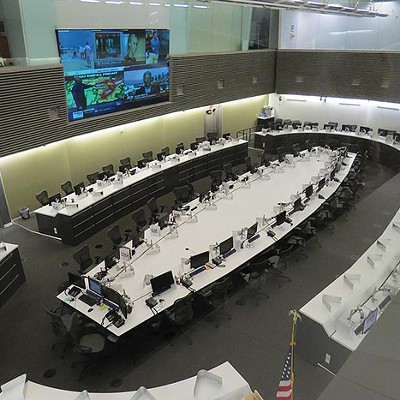The Illinois Independent Redistricting Amendment proposal that is likely to be on the fall ballot would set up a nonpartisan commission to draw legislative district boundaries now drawn by the General Assembly. Backers promise that the result would be districts that meet constitutional tests (“compact, contiguous and substantially equal in population”) rather than partisan ones. In districts thus drawn, voters will be able to pick their lawmakers rather than lawmakers pick their voters.
Better? I guess. I don’t know. I get confused when people talk about improving our system of political representation. I mean, which system of political representation are they talking about? Most Illinois legislative districts are defined by zip code, but some are defined by the skin color of the people who live in them. All of them share one problem – there are only 118 of them for the whole state, so the boundaries encompass more than one neighborhood or small town. Since no population of any size can be perfectly uniform in their opinions, so no one lawmaker can possibly represent all of them.
A constitutional amendment that changes the way members are selected could fix that, but it would have to be much bolder in concept than the one being touted by the fair remap forces. For example, we might expand on the principle at the heart of sanctioned racial gerrymandering, which is (as Mr. Quinn put it when he signed a 2011 law protecting minority populations from being split up during legislative redistricting) “to make sure that our racial minorities, our language minorities, citizens who live in a particular area, get a fair chance to elect a person of their choice.”
The goal in such cases is what is known as “descriptive representation,” meaning representation by one of your own, whoever “your own” happens to be. But blacks and browns are hardly the only people who feel that their representatives in Springfield don’t represent their interests. If it is a good thing to convert legislative districts into microcosms of the black community to achieve descriptive representation for that subpopulation, it ought to be good to offer descriptive representation for all by converting the House into a microcosm of Illinois.
I am not the only person to conclude that geography is the best or the only basis for representative government. The mapmakers of the California Citizens Redistricting Commission, a body very much like the one being proposed for Illinois, assumed that common cultural and economic interests rather than party alignment are the proper bases for political association. Taking myself as an example, my economic interests are with the lower middle class, but my cultural interests are shared with residents of university towns and upscale Chicago suburbs.
For that reason (among others), the representatives that most affect the lives of most citizens are not the ones they elect, but the ones they hire. I refer to the lobbyists who do the will of the professional guilds, the issues advocates, the labor unions, the business associations on which Illinoisans rely to tend to their interests in the capital. It’s not a new idea. Twenty-nine of the 70 members of the Legislative Council of Hong Kong represent “functional constituencies,” including insurance, education, the law, farming and fishing, accounting, all the health care sectors, engineering, labor, real estate, banking retailing, food, even sports and tourism. A General Assembly made up of lobbyists would be no less representative than a General Assembly made up of people influenced by lobbyists, and would spare the rest of us having to endure elections.
Is what we do – the Hong Kong model – the best basis for representation, or is it who we are, which underpins the creation of majority-minority districts based on ethnicity? If the latter, we need a legislature that more perfectly mirrors the public it purports to represent by making demographics the basis of selection. The members of a demographified Illinois House would have an Old Member, an African-American Member, a College-Educated Member, a Lutheran and a Catholic and a Jewish Member, plus members representing each of several income and wealth groups and so on, each of whom would cast weighted votes according to the proportion of the general population that member represents. Voters would vote for as many members as match their own personal demographic traits.
Fanciful? No more fanciful than expecting a single person to be able to represent the interests of Panther Creek, Loami and Laketown. Nor is districting the only ill of our election system, as I noted a while back (“Is this any way to run an election?,” March 25, 2010). But under such a system, Illinois would have a House of Representatives that really would be representative. It wouldn’t be very pretty and it wouldn’t be very efficient, but it would be very Illinois.
Contact James Krohe Jr. at [email protected].
Legislative little me’s
Basing representation on demography, not geography
[
{
"name": "Air - MedRect Combo - Inline Content 1",
"component": "11490391",
"insertPoint": "3",
"requiredCountToDisplay": "1",
"parentWrapperClass": "fdn-ads-inline-content-block"
},{
"name": "Air - MedRect Combo - Inline Content 2",
"component": "11490392",
"insertPoint": "7",
"requiredCountToDisplay": "5",
"parentWrapperClass": "fdn-ads-inline-content-block"
},{
"name": "Air - MedRect Combo - Inline Content 3",
"component": "11490393",
"insertPoint": "12",
"requiredCountToDisplay": "9",
"parentWrapperClass": "fdn-ads-inline-content-block"
}
]
In a country where people of like social class (and thus political views) tend to huddle together like bison in a blizzard, defining the geographical reach of a given legislative district goes a long way toward deciding which party represents it. The unhappy results include uncompetitive races, political stagnation and columns like this one.
Illinois Times has provided readers with independent journalism for almost 50 years, from news and politics to arts and culture.
Your support will help cover the costs of editorial content published each week. Without local news organizations, we would be less informed about the issues that affect our community..
Got something to say?
Send a letter to the editor and we'll publish your feedback in print!





















